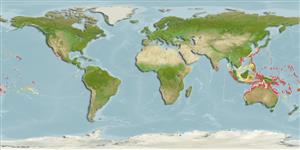>
Blenniiformes (Blennies) >
Blenniidae (Combtooth blennies) > Blenniinae
Etymology: Plagiotremus: Greek, plagios = oblique + Greek, trema = hole (Ref. 45335).
More on author: Whitley.
Environment: milieu / climate zone / depth range / distribution range
Ecologia
marino associati a barriera corallina; distribuzione batimetrica 0 - 30 m (Ref. 90102). Tropical; 33°N - 32°S
Western Pacific: Philippines and Ryukyu Islands to the Gilbert Islands, New Caledonia, and Samoa, north to Izu Islands, south to Rowley Shoals and Lord Howe Island; throughout Micronesia. Subspecies Plagiotremus laudandus flavus occurs in Fiji and Tonga.
Size / Peso / Age
Maturity: Lm ? range ? - ? cm
Max length : 8.0 cm TL maschio/sesso non determinato; (Ref. 9710)
Short description
Chiavi di identificazione | Morfologia | Morfometria
Spine dorsali (totale) : 7 - 10; Raggi dorsali molli (totale) : 27 - 30; Spine anali: 2; Raggi anali molli: 22 - 24. Color variable, usually grey-blue and posterior part of the body often paler or yellow (Ref. 48636).
Adults are found solitary in coastal, lagoon and seaward reefs from below the surge zone to 30 m depth (Ref. 9710, 90102). They feed on skin, scales, fins and mucus of other fish. Oviparous. Eggs are demersal and adhesive (Ref. 205), and are attached to the substrate via a filamentous, adhesive pad or pedestal (Ref. 94114). Larvae are planktonic, often found in shallow, coastal waters (Ref. 94114). A mimic of Meiacanthus atrodorsalis (Ref. 2334). Minimum depth reported taken from Ref. 128797.
Life cycle and mating behavior
Maturità | Riproduzione | Deposizione | Uova | Fecundity | Larve
Oviparous, distinct pairing (Ref. 205).
Myers, R.F., 1991. Micronesian reef fishes. Second Ed. Coral Graphics, Barrigada, Guam. 298 p. (Ref. 1602)
IUCN Red List Status (Ref. 130435: Version 2024-2)
Threat to humans
Harmless
Human uses
Strumenti
Special reports
Download XML
Fonti Internet
Estimates based on models
Preferred temperature (Ref.
123201): 25 - 29.3, mean 28.4 °C (based on 1729 cells).
Phylogenetic diversity index (Ref.
82804): PD
50 = 0.5005 [Uniqueness, from 0.5 = low to 2.0 = high].
Bayesian length-weight: a=0.00575 (0.00253 - 0.01308), b=3.06 (2.86 - 3.26), in cm total length, based on LWR estimates for this (Sub)family-body shape (Ref.
93245).
Trophic level (Ref.
69278): 4.4 ±0.80 se; based on food items.
Resilienza (Ref.
120179): Alto, tempo minimo di raddoppiamento della popolazione meno di 15 mesi (Preliminary K or Fecundity.).
Fishing Vulnerability (Ref.
59153): Low vulnerability (10 of 100).
Nutrients (Ref.
124155): Calcium = 148 [75, 276] mg/100g; Iron = 0.887 [0.489, 1.533] mg/100g; Protein = 18.6 [17.4, 19.7] %; Omega3 = 0.119 [0.063, 0.223] g/100g; Selenium = 22.6 [10.2, 53.0] μg/100g; VitaminA = 269 [93, 772] μg/100g; Zinc = 1.57 [0.99, 2.37] mg/100g (wet weight);
